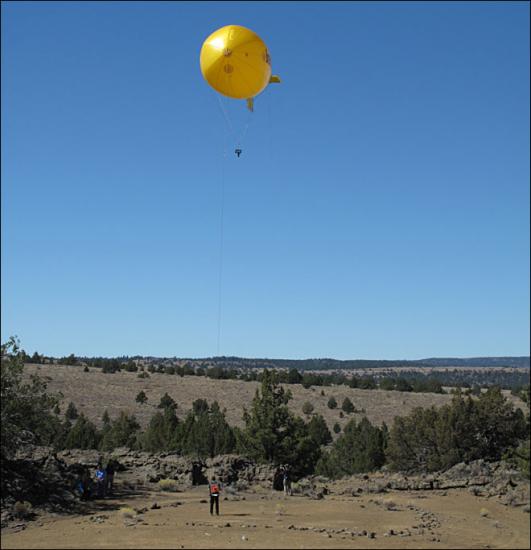Blimp helps UO document medicine wheels in Oregon
University of Oregon
Source - http://www.kval.com/news/local/Blimp-helps-UO-document-medicine-wheels-in-Oregon-139394513.html
 Teams used balloons and blimps outfitted with digital cameras to document the medicine wheels.
Teams used balloons and blimps outfitted with digital cameras to document the medicine wheels.
Efforts to document the first Native American Medicine Wheels ever reported in Oregon - led by Patrick O'Grady of the University of Oregon Museum of Natural and Cultural History - will be featured on Oregon Public Broadcasting's "Oregon Field Guide" television program at 8:30 p.m., Thursday, Feb. 23.
O'Grady, an archaeologist with the UO archaeology field school, has been using aerial photography to document the medicine wheels, which are large circular stone formations, sometimes with spokes radiating from the center.
Researchers believe Native peoples may have used them for ceremonial or religious purposes.
The story starts in 2007, when the Bureau of Land Management (BLM) discovered two large stone circles in the Stinkingwater Mountains of southeastern Oregon. Their importance was immediately recognized and brought to the attention of the University of Oregon.
UO deployed its field school personnel, students and volunteers in 2008 to record and survey the site.
Indeed, the stone circles turned out to be the first of their kind reported in Oregon. Medicine wheels are common in the Great Plains, but are extremely rare this far west.
The Oregon site is located on gravelly mineral deposits that can rapidly deteriorate from cattle tramping and the use of all terrain vehicles.
During the 2008 visit, UO personnel attempted to document the stone circles using laser transit, but because of the abundance of irregularly sized stones composing the two rings, adequate maps could not be generated. Another solution was needed, and quickly.
To further protect the site, the BLM and UO teams needed to produce survey studies to nominate the site for inclusion in the National Register.
In fall 2009 and summer 2010, the teams returned with helium balloons and camera equipment.
They tested both a 30-foot blimp and an eight-foot round balloon over the stone circles.
Attached to each was a 12.3-megapixel camera mounted on a carriage, or gimbal. The gimbal provided a 360-degree continuous pan and 100-degree tilt, vertical to horizontal -- with both camera and gimbal operated remotely by an airplane radio control unit.
The use of 3-D software found matching points on photos taken from different angles to create a surface model for photogrammetric measurement and visualization.
Resulting images create a remarkable record of the complexity and interaction of both feature and setting -- perfect materials to include in the site's nomination for the National Register.
Theories are beginning to emerge to explain the presence of the medicine wheels.
The Stinkingwater Mountains played a significant role in the seasonal roundup of the Northern Paiute people due to the abundance of root crops that emerge in the area in early spring. The plants provided a welcome respite from the scarcity of winter. Families would congregate at the root camps to socialize, gamble, race horses and catch up on the news.
The location attracted people from an area encompassing at the very least northeastern California, northern Nevada, western Idaho, southern Washington and much of Oregon east of the Cascades.
Excavations at Lost Dune, near Malheur Lake, add physical evidence to the historical documentation that travelers from the east, including Bannock and Shoshone, visited the area in the late pre-historic period.
"While we may never know exactly which cultural group might have been responsible for the stone circles," O'Grady says, "their rarity in this region deserves a level of protection that will guard them for future study."